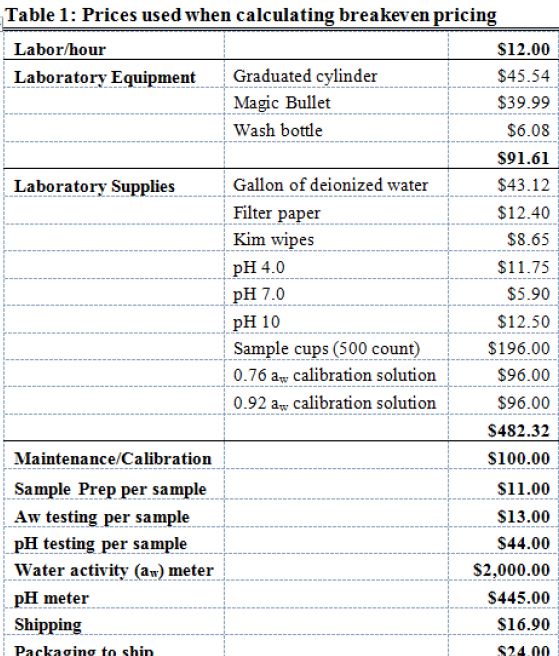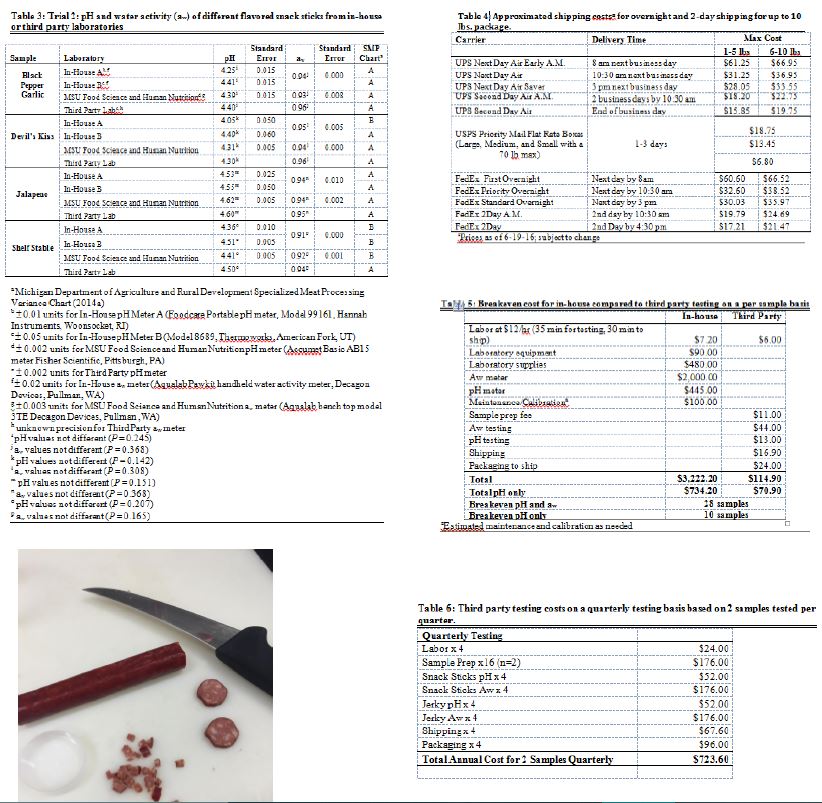
Specialized Meat Processing: Measuring pH and Water Activity In-house or Third Party
DOWNLOADFebruary 14, 2021 Jeannine Schweihofer
Why is pH and water activity important?
Product safety and shelf stability are impacted by product pH and aw. Testing is required for shelf stable processed meat products under the Michigan Department of Agriculture and Rural Development Specialized Retail Meat Processing Variance (Variance).
How often is testing needed with the Variance?
Products that are fully shelf stable require aw and pH testing for every batch, whereas products labeled “shelf stable, keep refrigerated upon opening” need two consecutive production batches tested initially and then quarterly testing.
What instruments were used?
- pH Meter A was a portable meter (Foodcare Portable pH meter, Model 99161, Hannah Instruments, Woonsocket, RI). pH Meter B was a handheld pen style pH probe (Model 8689, Thermoworks, American Fork, UT).
- Handheld aw meter (range from 0.00 - 1.00 ± 0.02; Aqualab Pawkit handheld water activity meter, Decagon Devices, Pullman, WA).
- All instruments were calibrated/verified according to manufacturer instructions at the beginning of each testing session. Results were not different among probes or testing laboratories (Table 3).
 How long does it take to test samples for pH and aw?
How long does it take to test samples for pH and aw?
It took approximately 34 minutes 35 seconds to measure pH and aw for one sample and 14 minutes 10 seconds for subsequent samples (Table 2). It is important to note that sample preparation and operation efficiency improved over time.
How was pH and aw measured?
Sample preparation and protocol: Sebranek and others, 2001. Available from Michigan State University Extension: Processed Meat Quick Guide: pH and water activity protocol.
What is the cost and time involved in third-party testing?
One set of samples was shipped to an accredited third party laboratory packaged in a foam box and kept cold using two frozen reusable gel packs. The package was shipped overnight and results emailed the next day (Tables 4 and 6).
How many samples have to be run in-house before breaking even?
Breakeven prices were calculated using set costs for each scenario (Table 1). The breakeven point was calculated by taking the sum of costs to be incurred doing in-house testing and dividing that by the total cost incurred sending samples to an accredited third party laboratory. It would take approximately 28 samples to breakeven (Table 5).
How is shelf stability determined?
The pH and aw criteria that must be met for shelf stability is displayed on the Specialized Retail Meat Processor (SRMP) process criteria chart (Figure 1; MDARD, 2014a). This chart displays the relationship of pH and aw and the points that may support the growth of potentially harmful organisms.
What other factors need to be considered?
Meter precision should be taken into account when using results to determine product safety. Factors such as temperature can affect pH readings and it is important to have a meter with automatic temperature compensation.
Does meter costs affect accuracy?
Despite the price difference in the pH meters, both gave acceptable results. All meters regardless of price should be properly calibrated and maintained to help reduce variability. Proper meter care and maintenance and spot checking against an accredited third party laboratory is encouraged.
Tables taken from Theisen and Schweihofer (2016).
REFERENCES:
- Michigan Department of Agriculture and Rural Development. (2014a). Specialized Meat Processing Variance and Extended Shelf Life for Retail Establishments (p. 5). Lansing, MI: MDARD. Available at: Michigan.gov/meatprocessing. Accessed: May 2016.
- Michigan Department of Agriculture and Rural Development. (2014b). Specialized Meat Processing Shelf Stability. Lansing, MI: MDARD. Available at: Michigan.gov/meatprocessing. Accessed: July 2016.
- Sebranek, J. G., Lonergan, S. M., King-Brink, M., & Larson, E. (2001). Meat science and processing. (3rd ed. p. 141). Zenda, Wis. Peerage Press.
- Theisen, M. & Schweihofer, J. (2016). Measuring pH and Water Activity in Cured Reduced Oxygen Packaged Snack Sticks. Journal of the NACAA. (Volume 9, Issue 2, December 2016).



 Print
Print Email
Email






